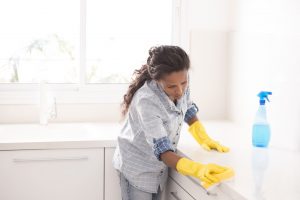We all know that hand washing is an important defense against coronavirus. As we work to keep ourselves and our families healthy, routine cleaning and disinfecting of areas in our homes is important. Cleaning removes dirt from surfaces, while disinfecting kills germs that remain after cleaning.
What is the best way to clean and disinfect the kitchen? Follow these steps:
- Clean kitchen counter-tops, pots and pans, and utensils with warm water and soap to remove germs, dirt, and food debris. Cleaning does not kill germs; cleaning removes germs and lowers the risk of spreading infection. Clean dishes, pots and pans, utensils, and other surfaces. A good physical cleaning that moves dirt and debris off surfaces is best. Scrub away!
- Using warm water, rinse away debris and rinse off soapy water, leaving behind a surface that is clean.
- After cleaning, disinfect surfaces as an extra precaution to kill germs that might remain. Disinfecting cleaned surfaces is a best practice to help to stop illness transmission.
What type of disinfects should be used? A dilute bleach solution or an EPA-registered disinfectant. The Centers for Disease Control (CDC) notes: EPA-registered disinfectants [can be used] that are appropriate for the surface, following label instructions. Labels contain instructions for safe and effective use of the cleaning product, including precautions you should take when applying the product, such as wearing gloves and making sure you have good ventilation during use of the product. A dilute bleach solution is easy to prepare using any standard, unscented household bleach using the following proportions:
Bleach Disinfectant for Kitchens
- 1 teaspoon bleach per quart (4 cups) of water
- 1 Tablespoon bleach per gallon of water
Prepare bleach solution and spray or wipe onto cleaned surface. Allow bleach solution to remain on clean surfaces for 1 minute. Wipe dry or (even better) allow to air dry. The chemicals will evaporate, leaving behind a disinfected surface. Use these proportions for any common, unscented household bleach containing 5.25 – 8.50% sodium hypochlorite. If stored in a closed container like a spray bottle, this solution will last for at least a week. Refresh each week as you deep-clean your kitchen.
The CDC recommends additional procedures for cleaning and disinfecting in a home where a person has a suspected or confirmed case of COVID-19.
- Wear disposable gloves when cleaning and sanitizing. Gloves should be discarded after each cleaning. If reusable gloves are used, those gloves should be dedicated for cleaning and disinfection of surfaces for COVID-19 and not used for any other purpose. Wash hands immediately after gloves are removed.
- Wash surfaces with soap and water. Always do this prior to disinfection.
- Disinfect with a strong bleach solution, a 70% alcohol solution, or EPA-registered household disinfectant (follow label directions).
- Preparing a strong bleach solution for home-care settings (bathrooms, sick rooms, etc):
- 5 Tablespoons (1/3 cup) bleach per gallon of water
- 4 teaspoons bleach per quart of water
- Allow to air dry.
- If this strong bleach solutions is used in the kitchen, be sure to rinse counter-tops, utensils, pots and pans, utensils, and any other food contact surface with clean water after disinfecting (it is not necessary to rinse bathroom surfaces).
- Preparing a strong bleach solution for home-care settings (bathrooms, sick rooms, etc):
What about surfaces like doorknobs and handles where it might not work to clean and then disinfect? For frequently touched surfaces (tables, doorknobs, light switches, handles, faucets…..) use standard household cleaners and EPA-registered disinfectants following label instructions. Labels contain instructions for safe and effective use of the cleaning product, including precautions you should take when applying the product, such as wearing gloves and making sure you have good ventilation during use of the product. More information here from the CDC. Stay food-safe and well.
Authored by: Barb Ingham




